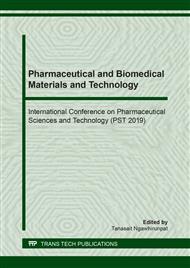p.145
p.151
p.157
p.163
p.169
p.175
p.181
p.187
p.195
Niosomes Containing Spermine-Based Cationic Lipid with Different Linkers for siRNA Delivery
Abstract:
Niosomes are a lipid nanoparticle which have been widely used as non-viral carrier for therapeutic DNA or siRNA. They are formulated from non-ionic surfactant and other helper lipids. The aim of this study were to formulate niosome containing spermine-based cationic lipid with different linkers and to evaluate the efficiency of siRNA delivery in cervical cancer cell (HeLa cell). The niosomes were formulated from cholesterol (Chol), Span 20 and different cationic lipid (Ay, By, Cy and Dy) at various molar ratios. The properties of niosomes and ability of niosome to complex with siRNA were characterized. The cellular uptake, gene silencing efficiency and cytotoxicity were also determined. From the results, niosomes formulated at Chol:Span20:lipid molar ratio of 2.5:2.5:2 showed positive zeta potential and they were in nanosize (<200 nm). The binding ability of cationic niosomes to siRNA depended on types of cationic lipid. Among niosome/siRNA complexes, the niosome By/siRNA complex provided the highest gene silencing efficiency at weight ratio of 20. The highest cellular uptake also obtained by using niosome By as a carrier. The cytotoxicity revealed that cationic niosomes had low toxicity (cell viability > 80%). In conclusion, the cationic niosomes prepared from Chol, Span 20 and spermine-based cationic lipids are able to complex with siRNA and suitable for siRNA delivery with low toxicity.
Info:
Periodical:
Pages:
169-174
Citation:
Online since:
August 2019
Keywords:
Price:
Сopyright:
© 2019 Trans Tech Publications Ltd. All Rights Reserved
Share:
Citation:


